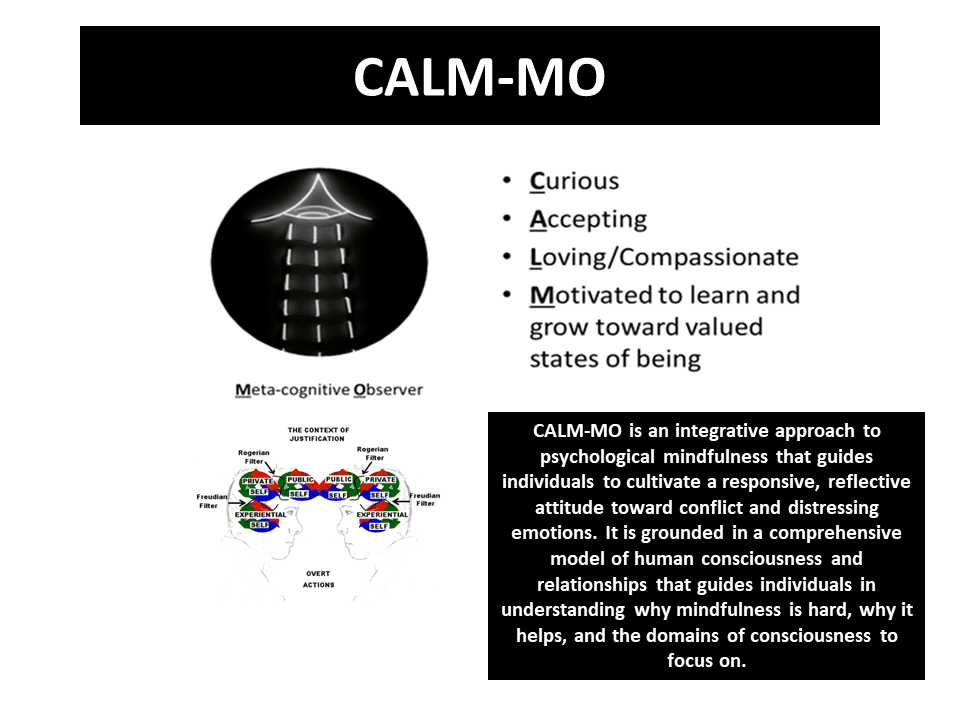CALM-MO is a psychological mindfulness tool in UTOK designed to interrupt neurotic loops and promote emotional attunement. It combines Curiosity, Acceptance, Loving Compassion, and Motivation (CALM) with a Meta-Observer (MO) perspective to foster healing through reflective emotional regulation.
Introduction
CALM-MO is the eighth key idea on UTOK's Tree of Life and a cornerstone of UTOK's Unified Approach to Psychotherapy. The concept offers a practical, integrative mindfulness strategy aimed at helping individuals navigate and overcome internalizing patterns of psychological suffering, especially those driven by neurotic loops. These loops—cyclical, negative patterns of thinking and emotional reactivity—are core drivers of internal psychological distress. CALM-MO serves as a heuristic for key principles in developing adaptive, emotionally attuned responses to adverse experiences and negative emotions.
Breaking Down the Acronym:
C – Curiosity: A nonjudgmental, open-minded approach to inner experiences, asking questions about emotional states rather than reacting impulsively.
A – Acceptance: A willingness to acknowledge and hold space for negative emotions or difficult situations without trying to immediately change them.
L – Loving Compassion: Offering kindness and empathy toward oneself and others in the face of emotional pain or adversity.
M – Motivation toward Valued States of Being: Moving through difficult experiences by grounding oneself in personal values and striving toward meaningful life goals.
The MO stands for Meta-Observer, which refers to cultivating a reflective, detached perspective on one's thoughts and emotions. By engaging the Meta-Observer, individuals can zoom out from their immediate emotional reactions and see their experiences from a broader, more distanced viewpoint. This reflective practice helps to reduce the intensity of emotional disturbances and allows for more thoughtful responses rather than automatic, often maladaptive, reactions.
The CALM-MO Flashlight Metaphor:
CALM-MO is frequently explained using the metaphor of a flashlight. The metaphor suggests that we must shine the CALM-MO flashlight into different layers of our psychological experience, each representing a dimension of our being:
Animal Body: Focus on basic sensations of safety, physical position, and bodily pleasure or pain.
Primate Heart: Acknowledge primary emotions like attachment, connection, and belonging.
Person Head: Address the narrative and self-conscious aspects of the human mind, including inner dialogue and self-reflection.
Spirit: Engage with one's deeper values, life purpose, and sense of meaning in the broader context of existence.
The purpose of this process is to hold negative feelings and adverse situations in mindful awareness, while attuning to each aspect of the self—body, emotions, thoughts, and spirit—with compassion and curiosity. This creates space for healing and transformation, as the individual learns to respond with calm, balanced energy rather than being caught in reactive, neurotic loops.
The Function of CALM-MO in Psychotherapy:
Within UTOK's Unified Approach to Psychotherapy, CALM-MO functions as a therapeutic tool to help clients develop greater emotional resilience. Grounded in UTOK's metapsychological framework, it helps clients cultivate a "meta-cognitive observer" as a modus operandi, empowering them to distance themselves from immediate emotional reactions. This distancing is not about detachment but rather about holding emotions with mindfulness and care, creating room for healthier socio-emotional processes.
CALM-MO operates both intra-psychically (within oneself) and interpersonally (in relationship with others). By integrating the principles of CALM and the MO, individuals can better navigate emotional turbulence, cultivate self-compassion, and enhance emotional intelligence in their relationships.
Practical Application:
In practical terms, CALM-MO encourages individuals to:
Reflect on their emotional experiences with curiosity and openness.
Practice acceptance of difficult emotions without the need for immediate change.
Cultivate self-compassion, treating oneself with kindness, especially during challenging times.
Stay motivated toward actions aligned with deeply held values, even in the face of adversity.
Adopt a meta-observer stance, where they can view themselves and their experiences from a zoomed-out perspective, providing emotional distance and clarity.
This mindful process helps individuals break free from the neurotic cycles that amplify psychological suffering, allowing them to cultivate a sense of peace and adaptive functioning in their daily lives.
Visual Aids
Links & Resources






